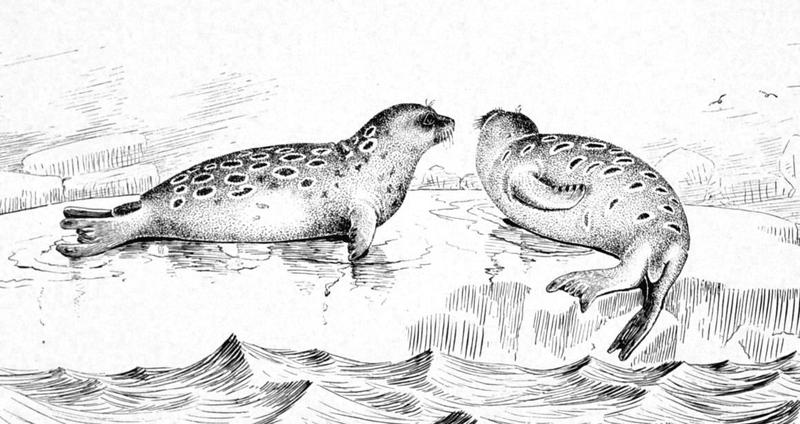|
| Query: Brown bear | Result: 275th of 578 | |
Ringed Seal (Pusa hispida) - Wiki
| Subject: | Ringed Seal (Pusa hispida) - Wiki
| |

| Resolution: 1158x614
File Size: 121700 Bytes
Upload Date: 2007:02:27 00:06:16
|
Ringed Seal
From Wikipedia, the free encyclopedia
[Photo] Phoca hispida (syn. Phoca foetida). From "The Fisheries and Fisheries Industries of the United States", by George Brown Goode (1887). http://www.photolib.noaa.gov/historic/nmfs/figb0273.htm
The Ringed Seal or Jar Seal (Pusa hispida formerly Phoca hispida) is an earless seal inhabiting the northern coasts. Also referred to by the Inuit as the Netsik or nattiq, typical adults are 85 to 160 cm long and 40 to 90 kg. They are quite long-lived seals, up to 45 years of age. Estimates of its population range around the 2-3 million mark. There are about 650000 ringed seals in Canada. The ringed seal are the only pinnipeds that maintain a breathing hole in the ice thus allowing it to use ice habitat that other seals can not.
Females reach maturity at 5-7 years while males reach sexual maturity from usually at 6-8 years old. Seal pups are born from mid March to early April. Gestation period is approximately 9 months. Seal pups depend on maternal care for 40 days and build up a thick layer of blubber. Due to the effects of global warming, icepacks have begun breaking up earlier than in the past. Birthing lairs are often destroyed before the seal pup is able to forage on its own leading to poor body condition.
The coat is a light grey spotted with black; the spots often being surrounded with lighter ring markings, from which this seal gets its vernacular name.
The populations living in different areas have evolved to separate subspecies, which are:
- Pusa hispida hispida: Arctic coasts of Europe, Russia, Canada and Alaska, including Novaya Zemlya, Spitsbergen, Greenland and Baffin Island.
- Pusa hispida krascheninikovi: North Bering Sea
- Pusa hispida ochotensis: Kamchatka, Okhotsk Sea and southward to 35°N, along the Japanese Pacific coast.
- Pusa hispida botnica Baltic Sea, Gulf of Bothnia and Gulf of Finland
- Pusa hispida ladogensis (Ladoga Seal) Lake Ladoga
- Pusa hispida saimensis (Saimaa Ringed Seal, saimaannorppa). Lives only in Lake Saimaa in Finland and is one of the most threatened seals in the world with total population around 250 individuals.
The three last subspecies are isolated from the others, like the closely related Nerpa (Baikal Seal).
Economic Importance
Examination of Early Paleoeskimo sites in Arctic Canada has demonstrated the deliberate hunting of juvenile and young adult ringed seals, probably in the fall and winter from frozen cracks and leads in the ice (Murray, 2005).
http://en.wikipedia.org/wiki/Ringed_Seal
| The text in this page is based on the copyrighted Wikipedia article shown in above URL. It is used under the GNU Free Documentation License. You may redistribute it, verbatim or modified, providing that you comply with the terms of the GFDL. |
|
Comments |
|---|
| | Guest |
|
Ringed Seal, Pusa hispida
The ringed seal, Pusa hispida (formerly Phoca), is the most abundant marine mammal in the Arctic, with a population size of at least one million animals. It is also the smallest seal; adults measure about 1.5 m long and weigh only 50 kg. They are brown to bluish black in colour with irregular creamy rings. Their scientific name, hispida means "rough, bristly, or hairy" and refers to their coarse hair.
Ringed seals are usually solitary, staying within 20 km of the coast, where they live on land-fast ice. They often venture into fiords, bays, and estuaries in search of food. Ringed seals feed primarily on fish ??? such as polar cod and herring ??? that provide enough resources to form the thick layer of blubber that keeps them warm. This layer of blubber also makes them attractive prey to polar bears, orcas, sharks, humans, and occasionally walrus.
As ice forms in the fall, each seal scrapes out a number of breathing holes with the strong claws on its front flippers. In early April, mature females enlarge one of their breathing holes and haul themselves out of the water. They then excavate tunnels and chambers in the snow on the pack ice where they give birth to their pups. At birth, the white pups weigh just 4 kg, but they quadruple their weight in just one month and enter the water within six weeks. |
| | Guest |
|
| coooooooooool |
^o^
Animal Pictures Archive for smart phones
^o^
|
|
|